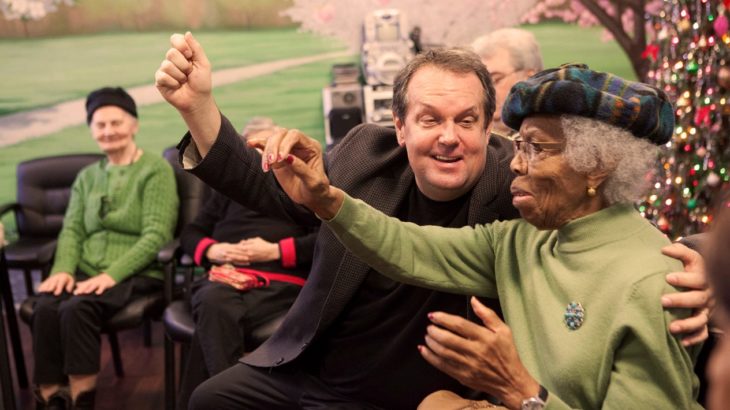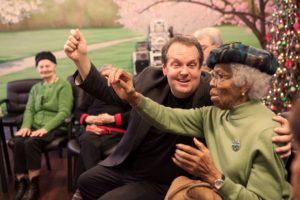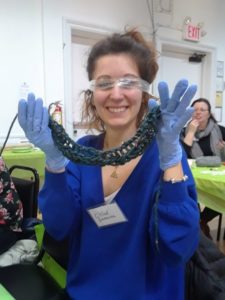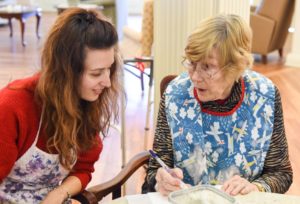
In the Spring of 2018 I was awarded a grant from the SWW DTP’s SDF fund which allowed me to undertake a five-week training in the USA. This trip, which occurred during the first year of my PhD, gave me the opportunity to observe, interview and train with key practitioners and scholars in the field of Arts & Dementia before undertaking my own field work. I travelled with three main goals in mind. Firstly, it was an occasion for me to discover some innovative and creative practices involving people living with dementia. My goal was not to focus on a particular art form, but rather to explore asset-based methods, which focus on imagination rather than memory and acknowledge the creative contribution of the participants living with dementia. This helped me enrich my own creative practice by providing me with new ideas and methods that I can adapt to the projects I lead in the UK. Secondly, it allowed me to gain a better understanding of the US social, political and economic context, especially in relation to ageing and dementia. Thirdly, it was a unique opportunity to ask scholars, who are key to my research, about their academic work and recently published articles. This blog gives an overview of some of the key projects I took part in.
The Alzheimer’s Poetry Project (APP) – Brooklyn, NYC
I spent my first morning in NYC participating in a poetry workshop led by Gary Glazner, the founder and Executive Director of the Alzheimer’s Poetry Project, (APP). The aim of the programme is to improve the quality of life of people living with dementia by using poetry as a medium to facilitate creative expression. The session took place at the New York Memory Centre in Brooklyn and included the participation of over 30 older adults, at various stages of dementia. The workshop was unlike anything I’ve seen before. Gary took my visit as a starting point for a session on travelling, focusing on France and people’s perception of the country. He asked me and the participants questions, making notes of everyone’s answers and acknowledging every contribution to create an original poem, on the spot. What impressed me was his ability to improvise and incorporate a variety of art forms to answer participant’s suggestions. Gary would, for example, include movements and rhythm, play the harmonica and even mix famous songs such as ‘I Feel Good’ to enhance the poetry session. This resulted in an incredibly dynamic workshop where participants felt free to be playful and creative.

The Creative Aging and Arts in Healthcare Training – Manhattan, NYC
I spent the rest of the week undertaking The Creative Aging and Arts in Healthcare Training at The Creative Centre at University Settlement. The programme was run by the inspirational Director of the Creative Centre, Robin Glazer, a cancer survivor and mother of five who is dedicated to continuing the momentum of hospital artist-in-residence programs throughout the United States. This busy week offered a comprehensive programme, including presentations, panel discussions, workshops and field trips. It aimed to give the trainees a comprehensive overview into the field of creative ageing. With an average of four activities a day, explaining every aspect of the programme would require a blog of its own. However, this week at The Creative Aging Centre made me aware of the varied range of practices taking place all over the country. What stood out from all these presentations was a real desire to try new practices and to respond to negative views on ageing and dementia through creativity. A recurrent theme throughout the week was to challenge the perception of ageing and dementia and to show the value of confidence building of a creative approach, which resonated with my own work and research.
Opening Minds through Art (OMA), Miami, Ohio

I then flew to Ohio where I spent two weeks training with the visual arts programme Opening Minds through Art (OMA) while auditing Gerontology classes at Miami University. OMA is an intergenerational art program specifically for people living with dementia that has for its mission ‘to build bridges across age and cognitive barriers through art’. I spent two weeks training with OMA and had the opportunity to observe eight sessions in various settings including community centres and nursing homes. I was able to participate in the programme myself and was involved in three sessions, working one to one with people living with dementia, as well as taking the online training and gain a facilitator qualification. Finally, I assisted with the OMA annual art show, a unique event which celebrates the work of the artist and the relationships with the students developed during the programme.

Creative Communities of Care, Milwaukee, Wisconsin
My last week was in Milwaukee with Joan Williamson, a fantastic drama practitioner who introduced me to various projects and artists within the local care community. The programme included:
- A tour of the two St Ann Centres for Intergenerational Care
- Meetings with student artists in residency from The University of Wisconsin-Milwaukee. Some of the students welcomed us to their studio and explained their creative process and the ways in which they immersed themselves in the life of the care home.
- A meeting with Angela Titus, LifeStreams and Volunteer Coordinator at St John on The Lack, to learn more about the SPARKS programme. Angela also gave us a tour of St John and explained how the place had transitioned into an innovative community of care.
- Participation in a TimeSlip session directed by students from The University of Wisconsin-Milwaukee.
- Meeting Anne Basting (my academic hero and the main scholar in my research…) with whom I went to see an intergenerational play written by one of the residents at Luther Manor care home.
All these activities contributed to exemplify how care homes could act as cultural hubs. From Luther Manor hosting high quality plays written by their residents, to St Ann Centre providing learning and work opportunities for the locals, it was inspiring to see the potential for care homes to be creative. These places were not positioned just as homes to care for senior citizens, but as spaces of social connections, celebrations and community building.
Conclusion
Throughout this trip, I met with a variety of artists, academics, students, administrators, carers and activities coordinators, across three different states. Although the settings and conditions of work differed, every person I met seemed driven by the same desire to combat the stigma surrounding dementia and ageing. I was inspired by the creativity, resourcefulness, resilience and generosity of these people, who often undertake a tremendous amount of work on a low income or voluntarily.
The participants living with dementia I met had varied levels of abilities; some people had full mobility and verbal capacities, while other were almost non-verbal and/or had difficulties with movement. Some people might have lost the ability to speak, but their facial expressions were worth a thousand words. Mostly though, all the people with whom I interacted had very different personalities, interests and backgrounds. I think that, as art practitioners, it is crucial to remember this and to consider the person as a whole, beyond the limitations caused by dementia. What makes a great creative programme is its ability to adapt to its participants, to find ways around physical or cognitive limitations so people can express themselves in the ways which they feel is the most appropriate for them. This can only be achieved through a relational process, one based on mutual respect, trust, patience and love. This reinforced to me the fact that skills of the facilitator play an important role and the training and support given to volunteers is crucial.
Categorised in: Student Blogs